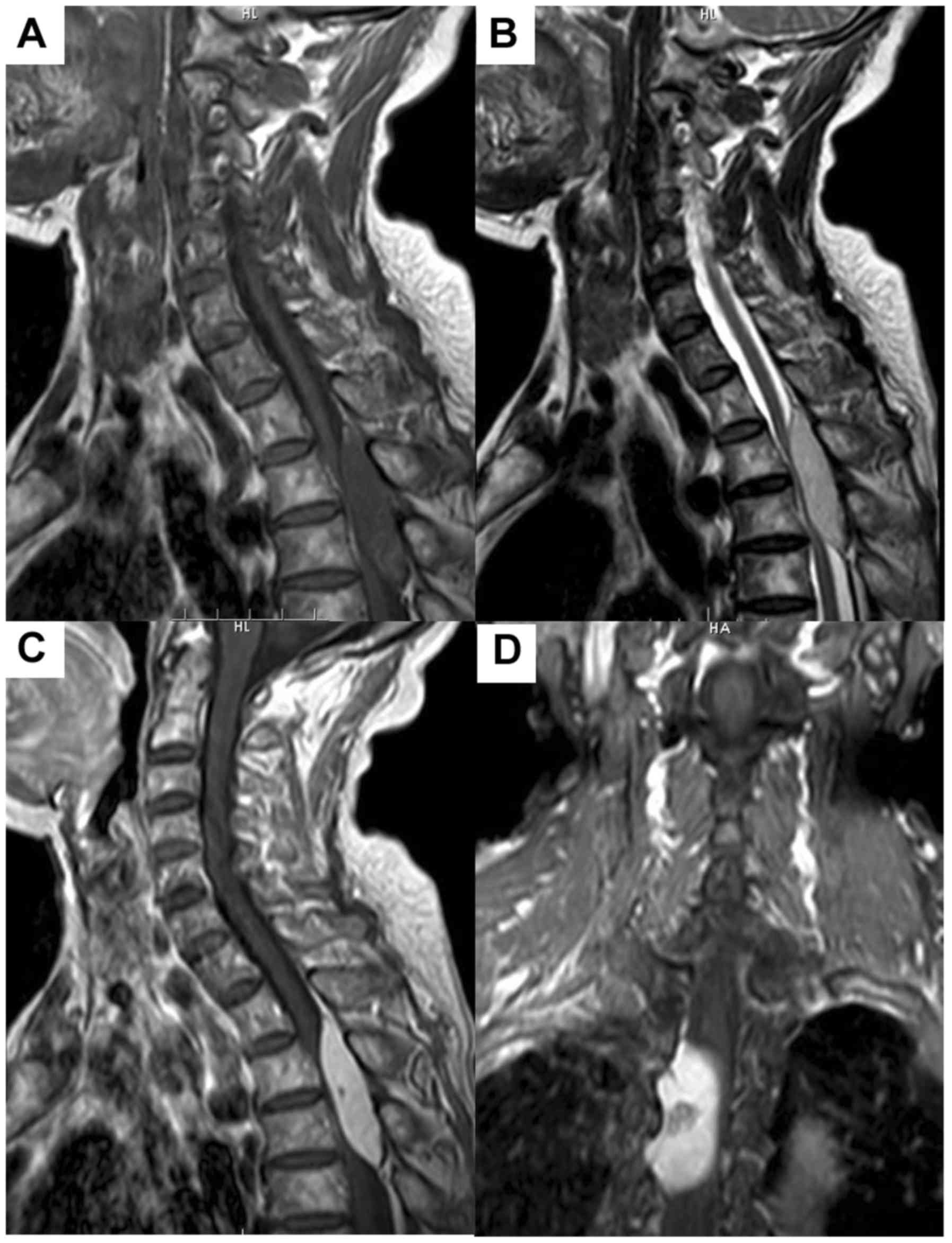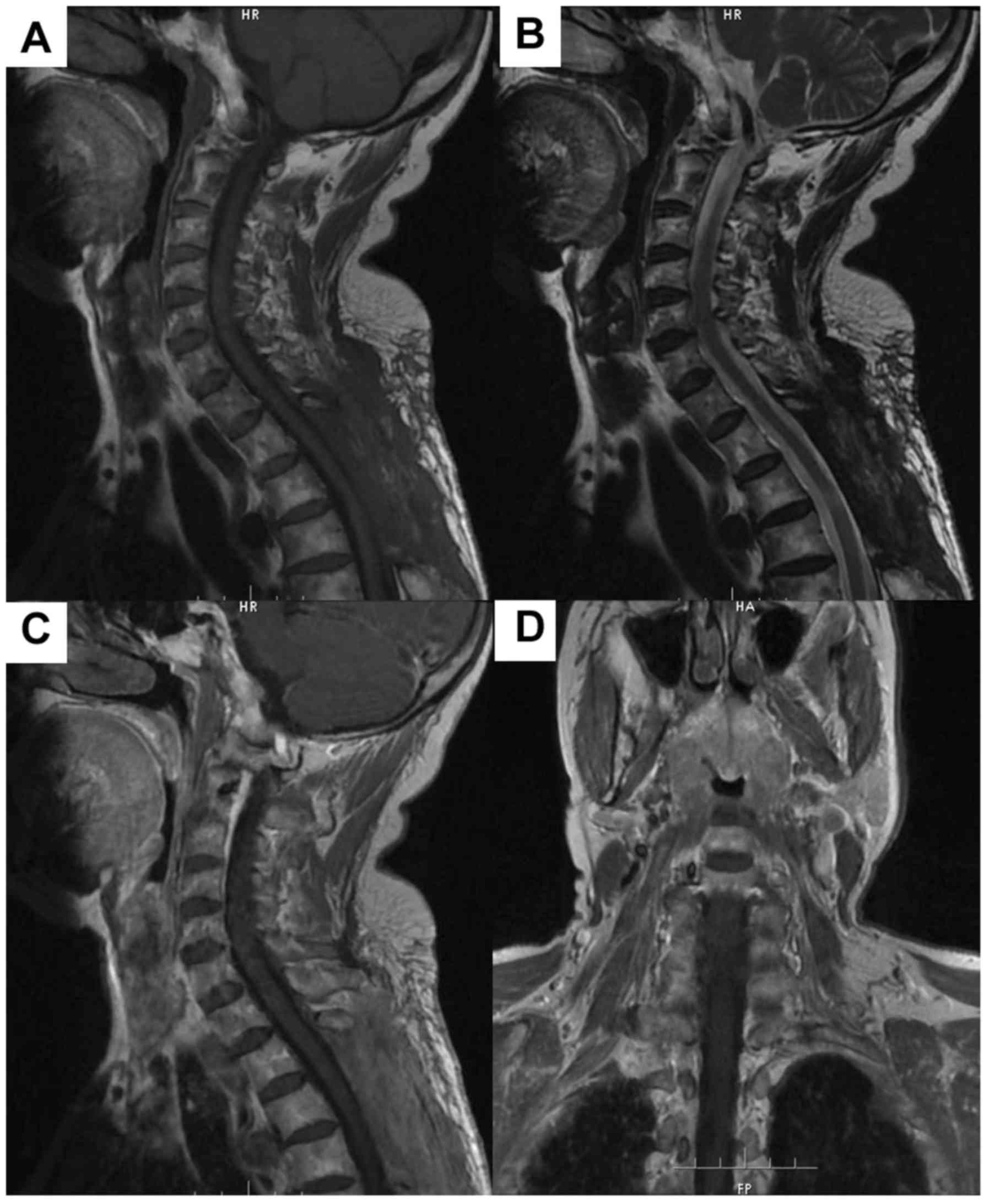|
1
|
Tong X, Deng X, Li H, Fu Z and Xu Y:
Clinical presentation and surgical outcome of intramedullary spinal
cord cavernous malformations. J Neurosurg Spine. 16:308–314. 2012.
View Article : Google Scholar : PubMed/NCBI
|
|
2
|
Zevgaridis D, Büttner A, Weis S, Hamburger
C and Reulen HJ: Spinal epidural cavernous hemangiomas. Report of
three cases and review of the literature. J Neurosurg. 88:903–908.
1998. View Article : Google Scholar : PubMed/NCBI
|
|
3
|
Talacchi A, Spinnato S, Alessandrini F,
Iuzzolino P and Bricolo A: Radiologic and surgical aspects of pure
spinal epidural cavernous angiomas. Report on 5 cases and review of
the literature. Surg Neurol. 52:198–203. 1999. View Article : Google Scholar : PubMed/NCBI
|
|
4
|
Aoyagi N, Kojima K and Kasai H: Review of
spinal epidural cavernous hemangioma. Neurol Med Chir (Tokyo).
43:471–475. 2003. View Article : Google Scholar : PubMed/NCBI
|
|
5
|
Hatiboglu MA, Iplikcioglu AC and Ozcan D:
Epidural spinal cavernous hemangioma. Neurol Med Chir (Tokyo).
46:455–458. 2006. View Article : Google Scholar : PubMed/NCBI
|
|
6
|
Caruso G, Galarza M, Borghesi I, Pozzati E
and Vitale M: Acute presentation of spinal epidural cavernous
angiomas: Case report. Neurosurgery. 60:E575–E576. 2007. View Article : Google Scholar : PubMed/NCBI
|
|
7
|
Sohn MJ, Lee DJ, Jeon SR and Khang SK:
Spinal radiosurgical treatment for thoracic epidural cavernous
hemangioma presenting as radiculomyelopathy: Technical case report.
Neurosurgery. 64:E1202–E1203. 2009. View Article : Google Scholar : PubMed/NCBI
|
|
8
|
Sarikaya-Seiwert S, Gierga K, Wessalowski
R, Steiger HJ and Hänggi D: Solitary spinal epidural cavernous
angiomas in children presenting with acute neurological symptoms
caused by hemorrhage. J Neurosurg Pediatr. 5:89–93. 2010.
View Article : Google Scholar : PubMed/NCBI
|
|
9
|
Floeth F, Riemenschneider M and Herdmann
J: Intralesional hemorrhage and thrombosis without rupture in a
pure spinal epidural cavernous angioma: A rare cause of acute
lumbal radiculopathy. Eur Spine J. 19 Suppl 2:S193–S196. 2010.
View Article : Google Scholar : PubMed/NCBI
|
|
10
|
Sanghvi D, Munshi M, Kulkarni B and Kumar
A: Dorsal spinal epidural cavernous hemangioma. J Craniovertebr
Junction Spine. 1:122–125. 2010. View Article : Google Scholar : PubMed/NCBI
|
|
11
|
Saracen A and Kotwica Z: Thoracic spinal
epidural cavernous haemangioma with an acute onset: Case report and
the review of the literature. Clin Neurol Neurosurg. 115:799–801.
2013. View Article : Google Scholar : PubMed/NCBI
|
|
12
|
Sharma MS, Borkar SA, Kumar A, Sharma MC,
Sharma BS and Mahapatra AK: Thoracic extraosseous, epidural,
cavernous hemangioma: Case report and review of literature. J
Neurosci Rural Pract. 4:309–312. 2013. View Article : Google Scholar : PubMed/NCBI
|
|
13
|
Bayri Y, Ekşi MŞ, Yalçınkaya Koç D and
Konya D: Spinal epidural cavernous angioma: Two case reports and
review of the literature. Acta Orthop Traumatol Turc. 49:459–464.
2015.PubMed/NCBI
|
|
14
|
Feng J, Xu YK, Li L, Yang RM, Ye XH, Zhang
N, Yu T and Lin BQ: MRI diagnosis and preoperative evaluation for
pure epidural cavernous hemangiomas. Neuroradiology. 51:741–747.
2009. View Article : Google Scholar : PubMed/NCBI
|
|
15
|
Zhong W, Huang S, Chen H, Sun H, Cai B,
Liu Y and You C: Pure spinal epidural cavernous hemangioma. Acta
Neurochir (Wien). 154:739–745. 2012. View Article : Google Scholar : PubMed/NCBI
|
|
16
|
Khalatbari MR, Abbassioun K and
Amirjmshidi A: Solitary spinal epidural cavernous angioma: Report
of nine surgically treated cases and review of the literature. Eur
Spine J. 22:542–547. 2013. View Article : Google Scholar : PubMed/NCBI
|
|
17
|
Li TY, Xu YL, Yang J, Wang J and Wang GH:
Primary spinal epidural cavernous hemangioma: Clinical features and
surgical outcome in 14 cases. J Neurosurg Spine. 22:39–46. 2015.
View Article : Google Scholar : PubMed/NCBI
|
|
18
|
Chiles BW III, Leonard MA, Choudhri HF and
Cooper PR: Cervical spondylotic myelopathy: Patterns of
neurological deficit and recovery after anterior cervical
decompression. Neurosurgery. 44:762–770. 1999. View Article : Google Scholar : PubMed/NCBI
|
|
19
|
Labauge P, Bouly S, Parker F, Gallas S,
Emery E, Loiseau H, Lejeune JP, Lonjon M, Proust F, Boetto S, et
al: Outcome in 53 patients with spinal cord cavernomas. Surg
Neurol. 70:176–181. 2008. View Article : Google Scholar : PubMed/NCBI
|
|
20
|
Barker FG III, Amin-Hanjani S, Butler WE,
Lyons S, Ojemann RG, Chapman PH and Ogilvy CS: Temporal clustering
of hemorrhages from untreated cavernous malformations of the
central nervous system. Neurosurgery. 49:15–24. 2001. View Article : Google Scholar : PubMed/NCBI
|
|
21
|
Gao W, Qiao X, Ma S, Ma J, Dong X, Qin T
and Fang Q: Contribution of skin trauma to infantile skin
hemangioma. Med Hypotheses. 76:512–513. 2011. View Article : Google Scholar : PubMed/NCBI
|
|
22
|
Demir MK, Ozdemir H, Unlu E, Temizöz O and
Genchellac H: Differential diagnosis of spinal epidural meningioma
and hemangioma at MR imaging. Radiology. 244:9332007. View Article : Google Scholar : PubMed/NCBI
|
|
23
|
Uchida K, Yayama T, Nakajima H, Hirai T,
Kobayashi S, Chen K, Guerrero AR and Baba H: Microsurgical
resection of cavernous haemangioma around the thoracic
neuroforamen: A case report. J Orthop Surg (Hong Kong). 18:370–373.
2010. View Article : Google Scholar : PubMed/NCBI
|
|
24
|
Demachi H, Takashima T, Kadoya M, Suzuki
M, Konishi H, Tomita K, Yonezawa K and Ubukata A: MR imaging of
spinal neurinomas with pathological correlation. J Comput Assist
Tomogr. 14:250–254. 1990. View Article : Google Scholar : PubMed/NCBI
|
|
25
|
Wu L, Yang T, Deng X, Yang C, Zhao L, Yao
N, Fang J, Wang G, Yang J and Xu Y: Spinal extradural en plaque
meningiomas: Clinical features and long-term outcomes of 12 cases.
J Neurosurg Spine. 21:892–898. 2014. View Article : Google Scholar : PubMed/NCBI
|
|
26
|
Gelabert-González M and García-Allut A:
Spinal extradural angiolipoma: Report of two cases and review of
the literature. Eur Spine J. 18:324–335. 2009. View Article : Google Scholar : PubMed/NCBI
|
|
27
|
Caroli E, Acqui M, Trasimeni G, Di Stefano
D and Ferrante L: A case of intraroot cauda equina cavernous
angioma: Clinical considerations. Spinal Cord. 45:318–321. 2007.
View Article : Google Scholar : PubMed/NCBI
|
|
28
|
Lee JW, Cho EY, Hong SH, Chung HW, Kim JH,
Chang KH, Choi JY, Yeom JS and Kang HS: Spinal epidural
hemangiomas: Various types of MR imaging features with
histopathologic correlation. AJNR Am J Neuroradiol. 28:1242–1248.
2007. View Article : Google Scholar : PubMed/NCBI
|
|
29
|
Gencpinar P, Açıkbaş SC, Nur BG, Karaali
K, Arslan M, Gurer EI, Duman O and Haspolat S: Epidural capillary
hemangioma: A review of the literature. Clin Neurol Neurosurg.
126:99–102. 2014. View Article : Google Scholar : PubMed/NCBI
|
|
30
|
Padovani R, Acciarri N, Giulioni M,
Pantieri R and Foschini MP: Cavernous angiomas of the spinal
district: Surgical treatment of 11 patients. Eur Spine J.
6:298–303. 1997. View Article : Google Scholar : PubMed/NCBI
|












